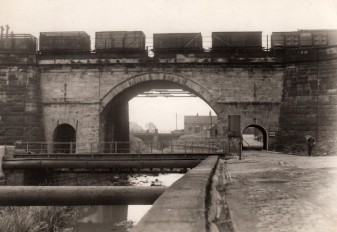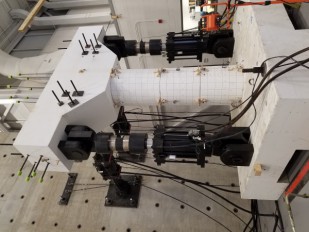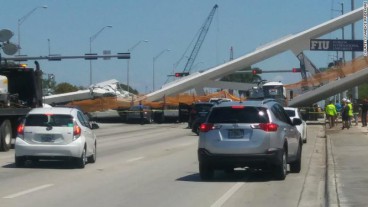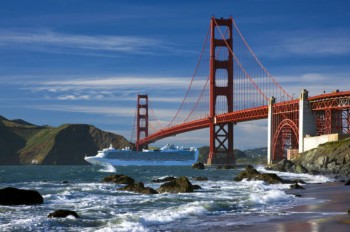How climate change is affecting the safety of bridges

A new study, recently published in the American Society of Civil Engineers (ASCE) Journal of Bridge Engineering, evaluates the impact of climate change on the safety of bridge constructions.
Bridge failures mostly occur due to erosion of the ground that surrounds a bridge foundation, a procedure known as scouring. Bridge scour is enabled when water removes soil material around the foundation, leaving holes that affect the stability of the structure.
Researchers, Dan M. Frangopol, Professor of Civil and Environmental Engineering at Lehigh University and Fazlur R. Khan Endowed Chair of Structural Engineering and Architecture, and David Y. Yang, Post-Doctoral Research Associate at Lehigh University, evaluated the scouring effect on bridges by quantifying the impact of temperature rise and increased precipitation caused by climate change. “We know climate change will increase the frequency and intensity of natural hazards like hurricanes, heatwaves, wildfires, and extreme rains,” Dr. Yang, stated.
In particular, scientists converted the climate simulation data into flow discharge by applying hydrologic modeling. Due to the fact that predicting the future climate involves numerous uncertainties, a group of different climate future models and global climate models was considered. The long-term hazard of bridge scour is evaluated using climate models under 3 climate change scenarios. Their approach was applied in the bridges of the Lehigh River.
According to Dr. Yang, it is the first attempt to evaluate climatology, hydrology, structural engineering, and risk assessment to quantify the impact of climate change on bridge safety.
Authors had to back-calculate the foundation depth of older bridges that exist along the Lehigh River as data is unavailable. They developed a method that includes utilizing the bridge condition rating provided by the National Bridge Inventory.
The analyses also considered regional data and life-cycle of the bridges, parameters that are significant to derive a general trend. “Bridges have a lot of microenvironments, and if you only look at one bridge, it’s really hard to capture the trend and get the increased risk from climate change. So we broadened this analytical horizon both spatially and temporally to capture long-term trends,” Dr. Yand, added.
The most significant finding of the analyses was the fact that flooding frequency is rapidly changing and, therefore, infrastructure may suffer unanticipated damage. “We realized that a 20-year flood may now become a 13-year flood at the end of the century, so that frequency nearly doubled. This is why climate change may induce an increased risk to infrastructure,” Dr. Yang concluded.
Scientists are willing to share their model in order to evaluate bridge vulnerability in more regions.
Source: Lehigh University
Source: Lehigh University
Want to read more like this story?

Iconic bridge in England receives repair works
Sep, 24, 2020 | NewsThe world's oldest operative railway bridge has recently undergone repair works. The fabled Skern...

Lake Polyfytos Bridge in Greece is closed for at least a month due to structural damage
Mar, 16, 2023 | NewsThe Lake Polyfytos Bridge, in Greece, has been closed due to structural damage. More specifically...

After the Recent NTSB Report: 68 U.S. Bridges Now Flagged for Collapse Risk
Mar, 29, 2025 | NewsWhen the Francis Scott Key Bridge in Baltimore catastrophically collapsed in March 2024 after being...

How climate change has affected real estate business
Nov, 11, 2019 | NewsClimate change is a phenomenon that leads to sea water-level rise affecting the coastal areas. But h...

New bridge design offers high earthquake resistance at lower cost
Sep, 30, 2020 | NewsA new study focuses on the implementation of new bridge designs that could provide earthquake resist...

Florida pedestrian bridge collapses 5 days after its installation
Mar, 21, 2018 | NewsThe bridge, which was expected to open in January 2019, was being built using a method called a...

Bridge Collapses in Bihar: A Wake-Up Call for Infrastructure Resilience
Aug, 13, 2024 | NewsIncreasing Incidents of Bridge Collapses in Extreme Weather The alarming frequency of bridge colla...

The most famous bridges of the world
Aug, 26, 2015 | NewsThere are so many bridges in the world in different styles, like old stone bridges or steely, footbr...

New research on more efficient bridges
Jun, 01, 2020 | NewsA new study reveals the high potential of reducing the materials used in suspension bridge construct...
Trending

Vertical gardens in Mexico City to combat pollution

Saudi Park Closed After 360 Big Pendulum Ride Crashes to Ground, 23 injured

Characteristics of Load Bearing Masonry Construction

Taipei 101’s impressive tuned mass damper

Dutch greenhouses have revolutionized modern farming

Federal court rules Biden’s offshore drilling ban unlawful


